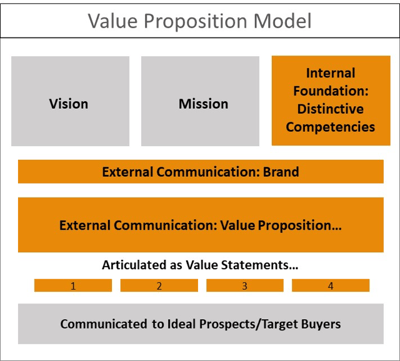CEO Blog - Advice for CEOs on growth and scaling
7 Ways Not to Screw Up Your Value Proposition


Value propositions are critical to the health and growth of your business. How critical you think they are may be colored by your personal experience. For me, a value proposition is a powerful summary of who you are and what you offer. It defines what is distinct and valuable for those prospects and customers that you want to reach.
A business associate recently said to me: “Now I get you, you’re all about creating value.” If our organizations are not creating value, what right to we have to continue to exist? If every business was lookalike--other than franchises which strive to create the same customer experience regardless of location--why should we exist?
Through years of working with small- and mid-market businesses, one theme continues. When someone says “We are a metal fabricator,” they only make that reference for your benefit or to provide context, because they will almost always follow that up with “But we’re not like other metal fabricators.” You can be part of NAICS Code 322, but that does not help someone understand who you really are, what you offer, what your capabilities are, and why they should do business with you. That last point: why they listen to your story about why should do business with you, is the essence of your value proposition.
Some might ask: “If value propositions are that important, why aren’t they more effective?” There are seven ways that I have seen clients of all sizes and across all industries screw up (or under-optimize, in consultant speak) their value propositions. Let’s review the list as well as best practices for building a killer value proposition.
Identify Distinctive Competencies
You may not have had an internal conversation around your business’ distinctive competencies recently—or maybe you’ve never had that conversation. But simply, they are the foundation of every value proposition.
A distinctive competence is best defined as a strong competency that is maintainable in the face of competition. It is not easily duplicated, at least for a while. It can be thought of as an "unfair advantage."
Distinctive competencies can come from technology, industry position, market relations, cost, business processes, manufacturing processes, people, customer satisfaction, or just being first to market.
Your value proposition needs to be solidly founded on your distinctive competencies. Value propositions aren’t aspirational (that’s the role of a Vision Statement). They translate what is unique about your business into something unique (like design or engineering services offered by manufacturers) and of value to your customers.

Write Your Value Proposition in Prospect and Customer-Facing Language
You’ve probably read value propositions that you will instantly recognize as being written by committee. Others seem like they are written by PhDs for PhDs. Yours must be written at the 10th grade reading level (a good average for readers today).
One suggestion I offer clients is this: think about a value proposition as if you are sitting across the table from a prospect and having an informal conversation. Never try to impress a potential customer with language they don’t use—you’ll lose them.
Here’s an example of writing in a more direct and simple style...
Instead of saying: “Our collaborative and hands-on engagement with customers, combined with expertise in processes, materials, and technology, creates innovative and high-performing products.”
Try something more direct: “We help you create innovative, high-performing products. Customers value our expertise in processes, materials, and technology.” That simple revision drops you down almost three grade levels in readability.
The Gunning Fog readability index is free and will help you understand the grade level you are writing to. Try it out here.
You can also use word clouds to understand what messages are really coming across to your readers. This blog explains how to do that.
Adopt an “Outside In” Approach
It will be challenging, but you have to incorporate more use of the second personal pronoun “You” and less use of the word “We.” Try talking about yourself but use the word “you” and see just how challenging this can be. But if you want to be effective in stating your value proposition, you have to try to get there. Time to stop navel gazing and take your customer’s perspective. Make the benefits you offer explicit.
We are all much more interested in conversations that engage us than talk “to” us. If you want your value proposition to be intrusive and memorable, using the work “You” will work much better for You.
And please, please, please, don’t start your value proposition with a sentence about when you were founded and how long you have been in business. Honestly, we don’t care. As much as we admire business longevity, we’d like to know right now what you can do for us right now.
Get Your Value Statements in the Right Order
Let’s say there are three or four major areas of value identified in your value proposition. In Marketing there has been long been a saying that “companies get the benefits list right but the order wrong.”
I’ve been personally guilty of this. In selling what became a multi-billion dollar deal with the Defense Department, I kept describing the service as a “cost-effective payment network with rich transaction detail.” The customer kept describing our offering as a “rich information system that got its detail from a payment transaction.” Both were benefits. However, the customer saw that the long term value of the information generated would be more powerful than what they would save on lower payment processing costs.
Once I realized that their view of value was different than mine, and that $1billion was at stake, I adopted their language!
Turn Value Propositions into Marketing Language
Once you have written your value proposition, you probably think you’re home free and everyone can start using it immediately. Hold on there, pardner. Someone in Marketing needs to polish it, refine it, validate it, refine it again, and add proof points to make it credible and more meaningful.
Proof points for each value statement included should be quantitative examples of benefits. Here’s an example: “Our collaborative design services often help customers reduce their costs by 22% or more.” Now are you more interested?
Proof points can also include industry certifications, third party awards, and anything else that makes your claims real and credible. If you can go the extra mile, customer testimonials help here...a lot.
Time to Reinforce and Police
I’ve worked in start-ups and Fortune 500 corporations, and I’ve never had the Marketing budget I thought I needed to introduce new positioning.
Someone in your organization needs to put the “police” badge on and insure that every time, in every medium and in every channel, your value position is presented in exactly the same language every time.
A branding guru once told me that “Your customers will get your new positioning before your employees will.” She was absolutely correct. After re-branding one business and introducing a new value proposition, in 10 months our customers fully understood our position. Two years after the launch, though, we still had salespeople who used the “old” company name. And don’t trust your staff to use your new collateral and presentations, either. That’s where policing comes in. Trust but verify.
Audit at Least Every Two Years
Value evolves in competitive landscapes. What is unique about your value offered today may be a market expectation tomorrow. My recommendation to clients is to complete a brand audit every two years. It’s not that expensive or time-consuming, and you can also combine sit with satisfaction questions and a net promoter score (NPS) loyalty study.
One example of evolving forms of value is power windows in automobiles. You can read more about that here.
In Summary
There was a motivational speaker who years ago gave me great advice. He said: “What is easy to do is often easy NOT to do.” Value propositions are not rocket science, but they are critical to your business and deserve your attention. Do them well.
This article is part of a series where I share practical experience learned over 25 years as a Marketing executive. I’m happy to engage with you if you want to expand on these ideas—and especially if you have a need, or know a company that does.
Topics: Value Proposition
Tue, Oct 10, 2017Related Articles

- Press Releases
- Careers
- Case Studies
- Marketing Consultant Company
- Marketing Strategy Consultants
- Marketing Plan Consultants
- B2B Marketing Consultants
- Virtual CMO
- Marketing Consultant Outsourcing
- Fractional CMO
- What is a Fractional CMO
- Healthcare Marketing Consultant
- Marketing Consultant Houston TX Texas
- Marketing Consultant Texas TX
- Marketing Consultant Bay Area
- CEO Blog
- Ebooks Plus
- Executive Marketing Consultants
- Product Marketing Consultants
- B2C Marketing Consultants
- Virtual Marketing Consultants
- Senior Marketing Consultants
- Temporary CMO
- Hire a CMO
- Fractional CMO Salary
- Fractional CMO Responsibilities
- Marketing Consultant Austin TX Texas
- Marketing Consultant Dallas TX Texas
- Marketing Consultant San Antonio
- Helping Private Equity
- Private Equity Blog
- Leadership Team
- Privacy Policy
- Business Marketing Consultants
- Strategic Marketing Consultants
- Marketing Technology Consultants
- Sales and Marketing Consultants
- CMO Job Description
- CMO Salary
- Fractional CMO Agency
- Fractional CMO Services
- CPG Marketing Consultant
- Marketing Consultant San Diego
- Partners
Houston, TX 77056
© 2023 Chief Outsiders


